1993 PONTIAC GRAND-AM check oil
[x] Cancel search: check oilPage 214 of 306
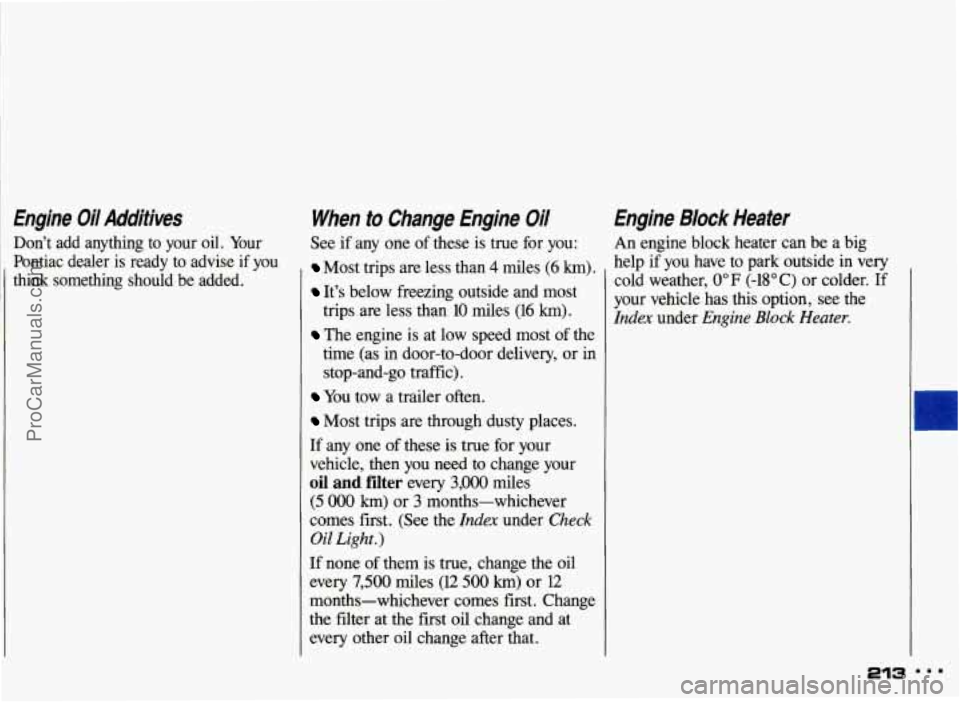
I
Engine Oil Additives
Don't add anything to your oil. Your
Pontiac dealer is ready to advise
if you
think something should be added.
When to Change Engine Oil
See if any one of these is true for you:
Most trips are less than 4 miles (6 km).
It's below freezing outside and most
trips are less than
10 miles (16 km).
The engine is at low speed most of the
time
(as in door-to-door delivery, or in
stop-and-go traffic).
You tow a trailer often.
Most trips are through dusty places.
If any one of these is true for your
vehicle, then you need to change your
oil and fdter every 3,000 miles
(5 0oO km) or 3 months-whichever
comes first. (See the
Index under Check
Oil Light.)
If none of them is true, change the oil
every
7,500 miles (12 500 km) or 12
months-whichever comes first. Change
the filter at the first oil change and at
every other
oil change after that.
Engine Block Heater
An engine block heater can be a big
help if you have to park outside
in very
cold weather,
0" F (-18°C) or colder. If
your vehicle has this option, see the
Index under Engine Block Heater.
213 I..
ProCarManuals.com
Page 217 of 306
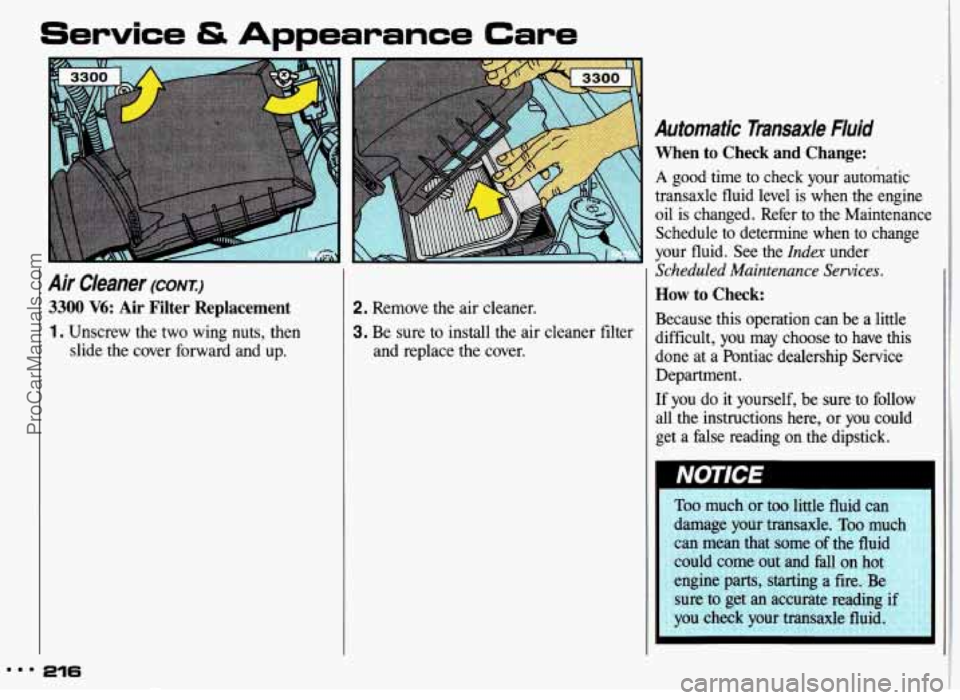
...
Service & Appearance Care
Air Cleaner (CONI)
3300 V6: Air Filter Replacement
1. Unscrew the two wing nuts, then
slide
the cover forward and up.
216
2. Remove the air cleaner.
3. Be sure to install the air cleaner filter
and replace the cover.
Automatic Tmnsax/e Fluid
When to Check and Change:
A good time to check your automatic
transaxle fluid level is when the engine
oil is changed. Refer
to the Maintenance
Schedule to determine when to change
your fluid. See the
Index under
Scheduled Maintenance Services.
How to Check:
Because this operation can be a little
difficult, you may choose to have this
done at a Pontiac dealership Service
Department.
If you do it yourself, be sure to follow
all the instructions here, or you could
get a false reading on the dipstick.
ProCarManuals.com
Page 219 of 306

Service & Appearance Care
Automatic Transaxle Fluid (CONT.)
How To Add Fluid:
Refer to the Maintenance Schedule to
determine what kind of transaxle fluid to
use. See the
Index under Fluids &
Lubricants.
If the fluid level is low, add only enough
of the proper fluid to bring the level into
the cross-hatched area on the dipstick.
It doesn’t take much fluid, generally less
than a pint. Don’t overfill. We
recommend you use only fluid
labeled DEXRON@-IIE, because fluids
with that label are made especially for
your automatic transaxle. Damage caused by fluid other than
DEXRON@-IIE is not covered by your
new vehicle warranty.
After adding fluid, recheck the fluid
level as described under
How tu Check.
When the correct fluid level is obtained,
push the dipstick back in all the way.
Manual Transaxle Fluid
When to Check:
A good time to have it checked is when
the engine oil is changed. However, the
fluid in your manual transaxle doesn’t
require changing.
How to Check:
Because this operation can be a little
difficult, you may choose to have this
done at a Pontiac dealership Service
Department.
If you do it yourself, be sure to follow
all the instructions here, or you could
get a false reading on the dipstick.
m.. 218
ProCarManuals.com
Page 256 of 306
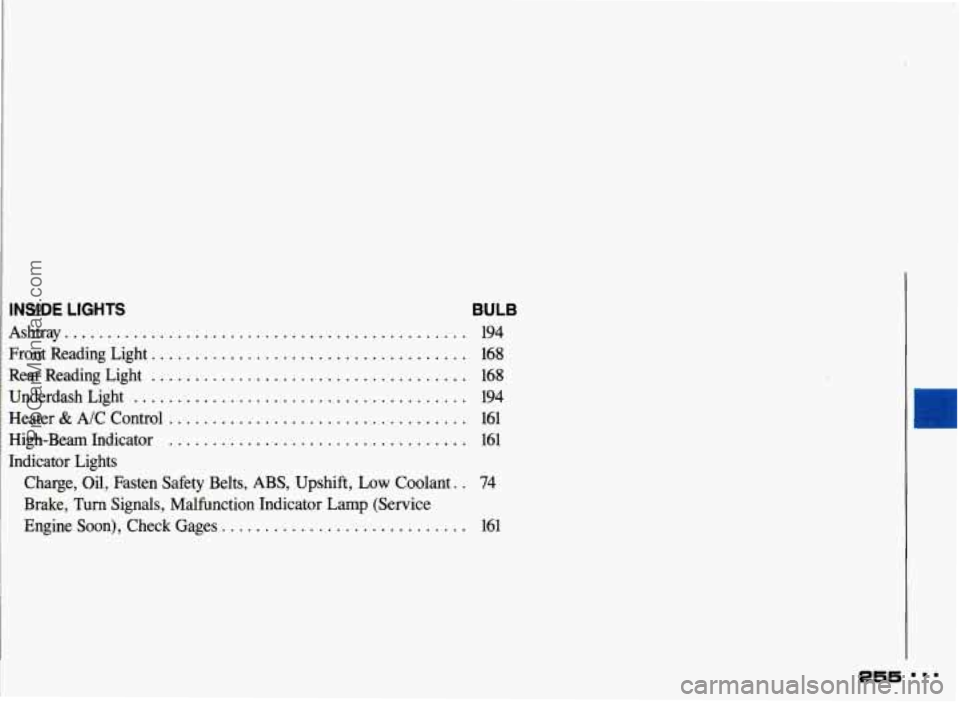
INSIDE LIGHTS BULB
Ashtray .............................................. 194
Front Reading Light.
................................... 168
Rear Reading Light .................................... 168
Underdash Light ...................................... 194
Heater
& A/C Control .................................. 161
High-Beam Indicator
.................................. 161
Indicator Lights Charge, Oil, Fasten Safety Belts,
ABS, Upshift, Low Coolant. . 74
Brake,
Turn Signals, Malfunction Indicator Lamp (Service
Engine Soon), Check Gages
............................ 161
E
255
ProCarManuals.com
Page 260 of 306
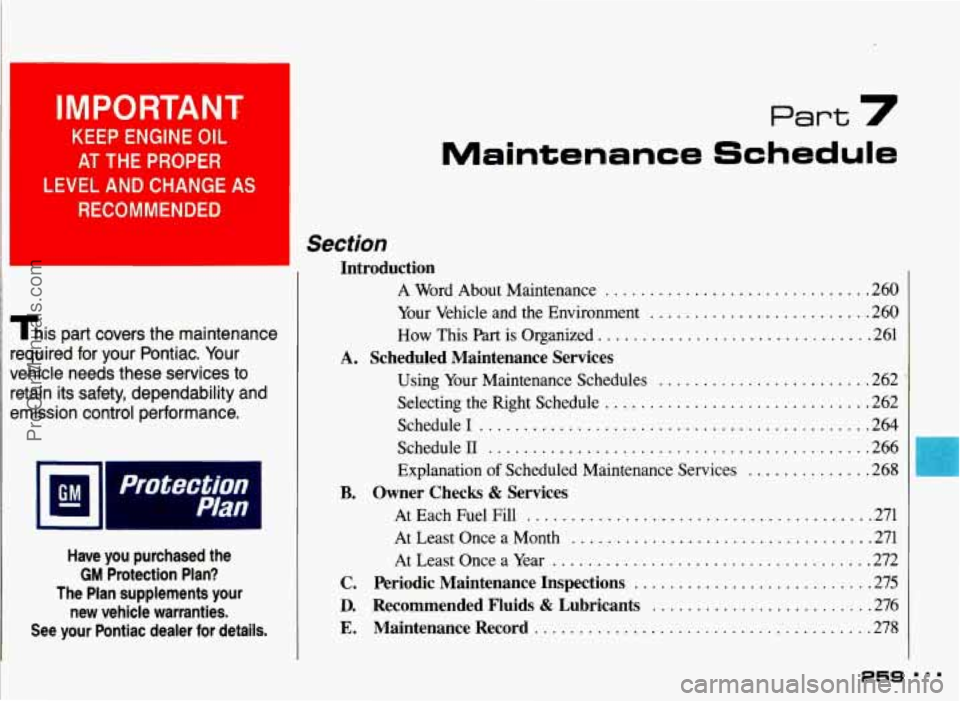
3 IMPORTANT
KEEP ENGINE OIL
AT THE PROPER
LEVEL AND CHANGE AS
RECOMMENDED
This part covers the maintenance
required for your Pontiac
. Your
vehicle needs these services to
retain its safety. dependability and
emission control performance
.
Section
Part 7
Maintenance Schedule
Have you purchased the
GM Protection Plan?
The Plan supplements your new vehicle warranties
.
See your Pontiac dealer for details .
Introduction
A Word About Maintenance ............................ 260
Your Vehicle and the Environment
......................... 260
How This Part is Organized ............................... 261
Using Your Maintenance Schedules
........................ 262
Selecting the Right Schedule
.............................. 262
Schedule1
............................................ 264
ScheduleII
......................................... 266
Explanation
of Scheduled Maintenance Services . . ... 268
A . Scheduled Maintenance Services
B . Owner Checks & Services
AtEachFuelFill ....................................... 271
At Least Once a Month
.................................. 271
At Least Once a Year
.................................... 272
C . Periodic Maintenance Inspections ........................... 275
D . Recommended Fluids & Lubricants ......................... 276
E . MaintenanceRecord ...................................... 278
259
ProCarManuals.com
Page 269 of 306
![PONTIAC GRAND-AM 1993 Owners Manual Maintenance Schedule
Section A: Scheduled Maintenance Services [cant.]
Explanation of Scheduled Maintenance Services
Below are explanations of the services listed in Schedule I
and Sched PONTIAC GRAND-AM 1993 Owners Manual Maintenance Schedule
Section A: Scheduled Maintenance Services [cant.]
Explanation of Scheduled Maintenance Services
Below are explanations of the services listed in Schedule I
and Sched](/manual-img/50/58387/w960_58387-268.png)
Maintenance Schedule
Section A: Scheduled Maintenance Services [cant.]
Explanation of Scheduled Maintenance Services
Below are explanations of the services listed in Schedule I
and Schedule II.
The proper fluids and lubricants to use are listed in
Section D. Make sure whoever services your vehicle uses
ITEM
NO. SERVICE
1 Engine Oil and Filter Change-Always use SG
Energy Conserving 11 oils of proper viscosity.
The “SG” designation may be shown alone or
in
combination with others, such as “SG/CC,”
“SG/CD” or
“SF, SG, CC,” etc. If you have the
2.3L Quad OHC or a Quad
4 engine, the preferred
viscosity for your vehicle’s engine is
SAE 5W-30.
However, you can use
SAE 1OW-30 if it’s going to
be
0°F (-18°C) or above. If you have the 3300 V6
engine, the preferred viscosity for your vehicle’s
engine is
SAE 1OW-30. However, you can use SAE
5W-30 if it’s going to be 60°F (16°C) or below. these. All parts should be replaced and all necessary repairs
done before you or anyone else drives the vehicle.
NOTE: To determine your engine’s displacement and code,
see the
Index under Engine Identijication.
ITEM
NO.
2
3
4
SERVICE
Chassis Lubrication-Lubricate the transaxle shift
linkage, parking brake cable guides, underbody
contact points and linkage. Lubricate the front and
rear suspension, steering linkage and fuel filler
door and striker plunger.
Throttle
Body Mounting Bolt Torque (3300 V6
Code N engine)*-Check the torque of the
mounting bolts and/or nuts.
Tire and Wheel Rotation and Inspection-For
proper wear and maximum tire life, rotate your
tires following the instructions in this manual. See
the
Index under llres, Inspection & Rotation.
Check the tires for uneven wear or damage. If you
see irregular or premature wear, check the wheel
alignment. Check for damaged wheels
also.
* An Emission Control Service.
i? The US. Environmental Protection Agency has determined that the failure to pe@orm this maintenance item will not nullifL the emission warranty or
limit recall liability prior to the completion
of vehicle useful life. General Motors, however, urges that all recommended maintenance sem’ces be
peflormed at the indicated intervals and the maintenance be recorded in Section E: Maintenance Record.
268
ProCarManuals.com
Page 270 of 306

ITEM
NO. SERVICE
5 Engine Accessory Drive Belt Inspection*-
Inspect the belt. for cracks, fraying, wear and
proper tension. Replace
as needed.
6 Cooling System Service*-Drain, flush and refill
the system with new or approved recycled coolant
conforming to
GM Specification 1825M. Keep
coolant at the proper mixture as specified. See the
Index under Coolant. This provides proper freeze
protection, corrosion inhibitor level and engine
operating temperature.
Inspect hoses and replace if they are cracked,
swollen or deteriorated. Clean the outside of the
surge
tank and air conditioning condenser.
To help ensure proper operation, we recommend a
pressure test
of both the cooling system and the
surge
tank pressure cap.
doesn’t require changing.
7 Transaxle Service-For a manual transaxle, fluid
ITEM
NO. SERVICE
For an automatic transaxle, change both the fluid
and filter every
15,000 miles (25 OOO krn) if the
vehicle is mainly driven under one or more
of these
conditions:
In heavy city traffic where the outside temperature
regularly reaches 90°F
(32OC) or higher.
In hilly or mountainous terrain.
When doing frequent trailer towing. With some
models, you shouldn’t even tow a trailer. See the
Index under Towing a Trailer.
Uses such as found in taxi, police car or delivery
service.
8
9
If you do not use your vehicle under any of
these conditions, change both the fluid and filter
every 100,000 miles
(160 000 km).
Spark Plug Replacement *-Replace spark plugs
with the proper type. See the
Index under
Replacement Parts.
Spark Plug Wire Inspection (3300 V6 Code N
engine)**-Inspect for burns, cracks or other
damage. Check the boot fit at the coils and at the
spark plugs, Replace wires as needed.
ProCarManuals.com
Page 272 of 306
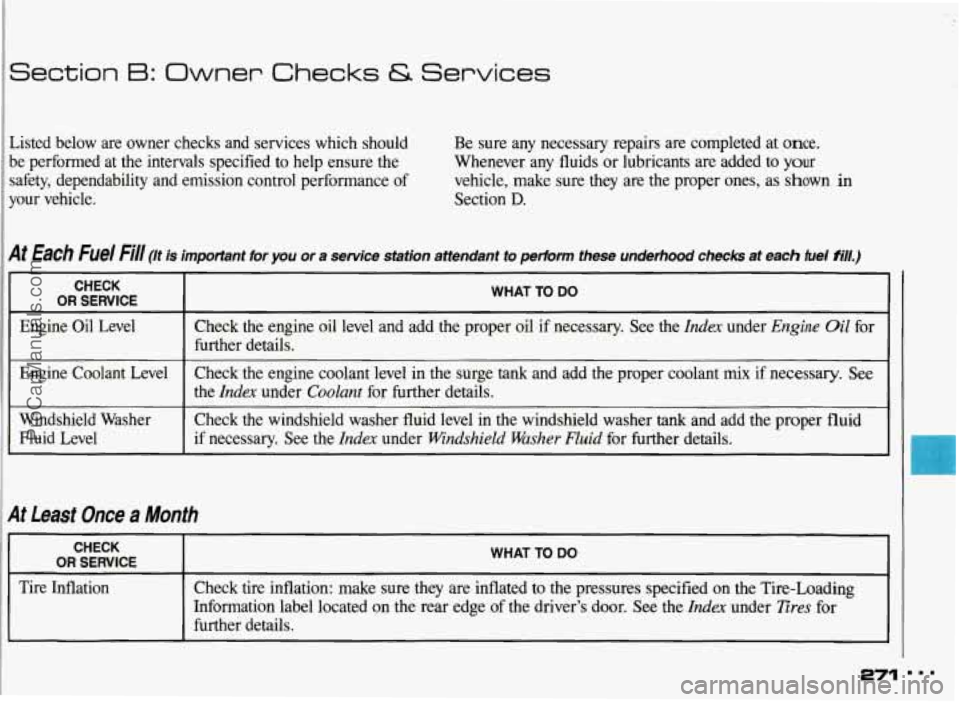
Section B: Owner Checks 6 Services
Listed below are owner checks and services which should
be performed at the intervals specified to help ensure the
safety, dependability and emission control performance of
your vehicle. Be
sure any necessary repairs are completed at once.
Whenever any fluids or lubricants are added to your
vehicle, make sure they are the proper ones, as shown in
Section
D.
At Each Fuel Fill (It is important for you or a service station attendant to perhrm these underhood checks at each fuel fill.)
CHECK
I OR SERVICE I WHAT TO DO
Engine Oil Level
I Engine Coolant Level
I
I
Windshield Washer
Fluid Level Check the
engine oil level and add the proper oil if necessary. See the
Index under Engine Oil for
further details.
Check the engine coolant level in the surge
tank and add the proper coolant mix if necessary. See
the Index under Coolant for further details.
Check the windshield washer fluid level in the windshield washer
tank and add the proper fluid
if necessary. See the
Index under Windshield Washer Fluid for further details.
At Least Once a Month
CHECK
WHAT TO DO OR SERVICE
Tire Inflation Check tire inflation: make sure they are inflated to the pressures specified on the Tire-Loading
Information label located on the rear edge of the driver's door. See the
IndRx under Eres for
further details.
ProCarManuals.com